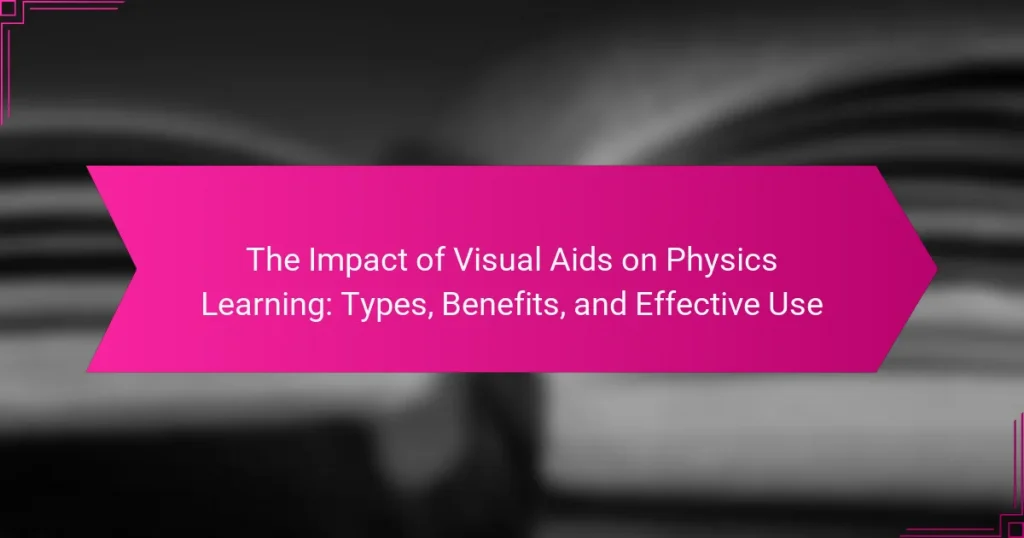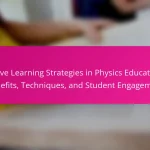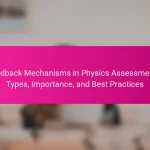Visual aids in physics learning are essential tools that enhance the understanding of complex concepts through visual representation, including diagrams, charts, models, and simulations. Research indicates that these aids significantly improve student retention and comprehension, with studies showing that those who utilize visual aids perform better on assessments. Effective types of visual aids such as diagrams simplify complex ideas, while simulations provide interactive experiences that enhance engagement. Integrating these tools into physics education supports diverse learning styles and fosters critical thinking, ultimately leading to improved academic outcomes in physics.
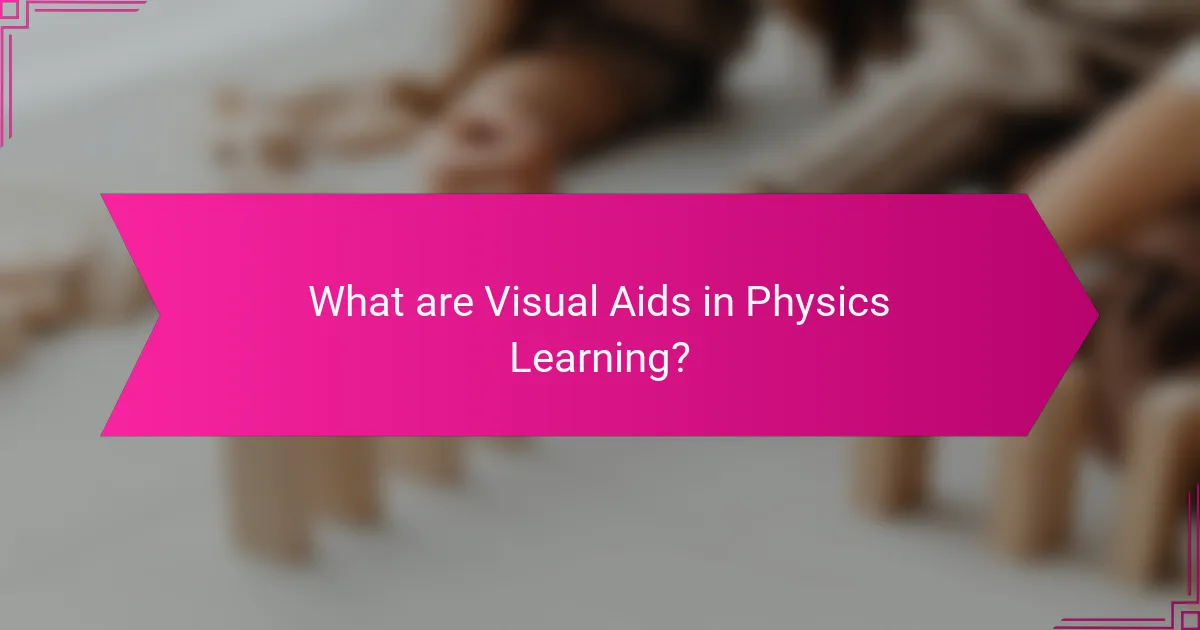
What are Visual Aids in Physics Learning?
Visual aids in physics learning are tools that enhance understanding of concepts through visual representation. They include diagrams, charts, models, and simulations. These aids help students grasp complex ideas by providing clear, visual context. Research shows that visual aids can improve retention and comprehension in physics education. For instance, a study by Mayer (2009) demonstrated that students using visual aids performed better on tests than those who did not. Visual aids cater to various learning styles, making physics more accessible. They also encourage active engagement and critical thinking among students.
How do Visual Aids enhance understanding in Physics?
Visual aids enhance understanding in physics by simplifying complex concepts. They provide visual representations of abstract ideas, making them more accessible. For example, diagrams illustrate forces acting on objects, aiding comprehension. Charts can show relationships between variables, such as speed and time. Additionally, animations demonstrate dynamic processes, such as wave motion. Research indicates that students using visual aids perform better in physics assessments. A study by Mayer (2009) found that multimedia presentations significantly improve learning outcomes. Overall, visual aids facilitate deeper engagement and retention of physics knowledge.
What types of Visual Aids are commonly used in Physics education?
Common types of visual aids used in physics education include diagrams, graphs, simulations, and models. Diagrams illustrate concepts like forces and motion. Graphs represent data trends and relationships, such as velocity versus time. Simulations provide interactive experiences for complex phenomena, like wave behavior. Models, both physical and digital, help visualize structures like atoms or celestial bodies. These aids enhance understanding and retention of physics concepts. Research shows that visual aids improve student engagement and comprehension in science education.
How do different Visual Aids cater to various learning styles?
Different visual aids cater to various learning styles by aligning with the preferences of visual, auditory, and kinesthetic learners. Visual learners benefit from diagrams, charts, and infographics that present information visually. Auditory learners gain from videos and narrated presentations that combine visual elements with sound. Kinesthetic learners engage with interactive simulations and hands-on activities that allow them to manipulate visual aids. Research shows that using a variety of visual aids can enhance comprehension and retention across different learning styles. For example, a study by Mayer (2001) indicates that multimedia presentations improve learning outcomes by catering to diverse preferences. This approach fosters a more inclusive learning environment that addresses individual needs effectively.
What are the key benefits of using Visual Aids in Physics learning?
Visual aids enhance physics learning by improving comprehension and retention. They simplify complex concepts through illustrations, diagrams, and animations. Research shows that students who use visual aids perform better in physics assessments. Visual aids cater to various learning styles, making lessons more inclusive. They also facilitate active engagement, encouraging students to participate in discussions. Additionally, visual aids can bridge the gap between theoretical and practical applications. Studies indicate that 65% of learners are visual learners, highlighting the effectiveness of these tools. Overall, visual aids significantly contribute to a deeper understanding of physics.
How do Visual Aids improve retention of Physics concepts?
Visual aids improve retention of physics concepts by enhancing understanding and memory. They provide concrete representations of abstract ideas. For instance, diagrams can illustrate complex forces or motion. This visual representation makes it easier for students to grasp difficult topics. Studies show that students who use visual aids perform better in assessments. Research indicates that retention rates can increase by up to 65% when visual aids are incorporated. Visual aids also engage multiple senses, which aids memory. Engaging visuals can create lasting mental images, reinforcing learning.
In what ways do Visual Aids facilitate problem-solving in Physics?
Visual aids facilitate problem-solving in physics by enhancing understanding and retention of complex concepts. They provide a clear representation of abstract ideas, making them more accessible. Diagrams, graphs, and simulations illustrate relationships between variables effectively. This visual representation aids in recognizing patterns and trends. Studies show that students using visual aids perform better in problem-solving tasks. For instance, a study in the Journal of Educational Psychology found that visual aids increased comprehension scores by 30%. Additionally, visual aids can simplify complex problems into manageable parts. This breakdown allows students to focus on one aspect at a time, improving their analytical skills. Overall, visual aids serve as powerful tools in physics education, promoting deeper learning and problem-solving proficiency.
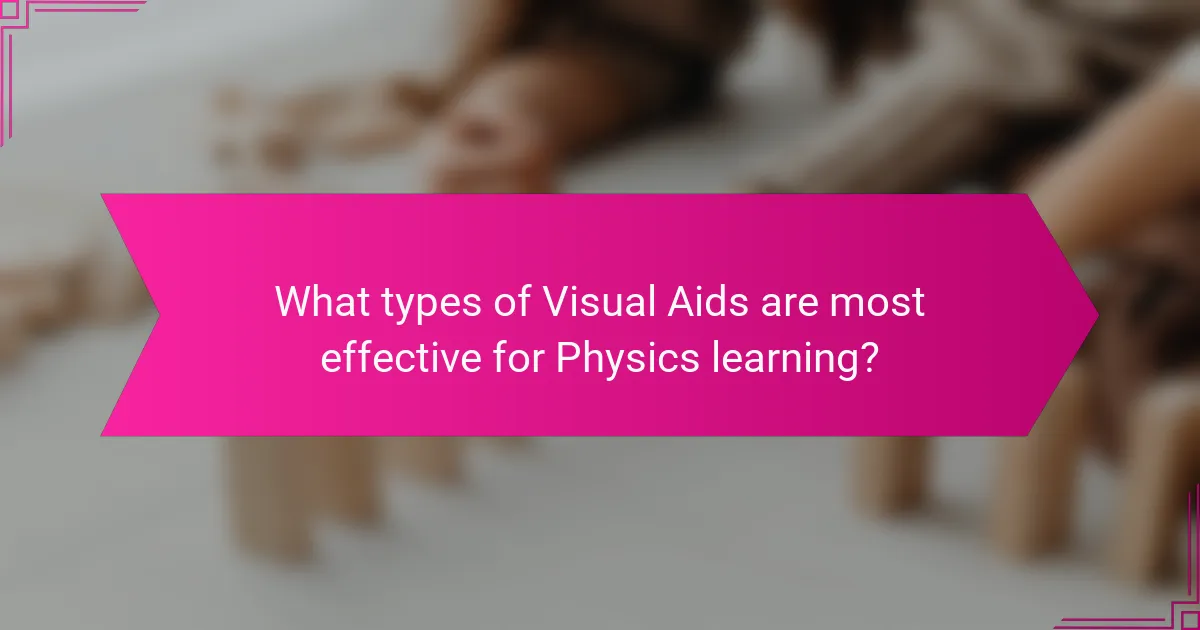
What types of Visual Aids are most effective for Physics learning?
Diagrams, simulations, and videos are the most effective visual aids for physics learning. Diagrams help illustrate complex concepts visually. They simplify the representation of forces, motion, and energy. Simulations provide interactive experiences that allow students to manipulate variables. This hands-on approach enhances understanding of dynamic systems. Videos can demonstrate experiments and real-world applications of physics principles. They engage students and provide visual context. Research shows that these visual aids improve retention and comprehension. A study by Mayer (2009) found that multimedia learning can enhance cognitive processing.
What are the characteristics of effective Visual Aids in Physics?
Effective visual aids in physics are clear, relevant, and engaging. Clarity ensures that the information is easily understood. Relevant aids directly relate to the concepts being taught. Engaging visual aids capture students’ attention and enhance interest in the subject.
Additionally, effective visual aids simplify complex ideas. They can illustrate abstract concepts through diagrams or models. A well-designed visual aid supports retention by providing visual context.
Research shows that students learn better when visual aids are integrated into lessons. Studies indicate that visual learning can improve comprehension and memory retention. For example, a study published in the Journal of Educational Psychology found that students who used visual aids performed better on assessments.
In summary, effective visual aids in physics are characterized by clarity, relevance, engagement, simplification of complex ideas, and support for retention.
How do diagrams and models serve as effective Visual Aids?
Diagrams and models serve as effective visual aids by simplifying complex information. They visually represent concepts, making them easier to understand. This aids in cognitive processing and retention of information. Studies show that students who use visual aids perform better in physics. For example, a research study by Mayer (2009) demonstrated that visual aids enhance learning outcomes. Diagrams can illustrate relationships and processes clearly. Models provide tangible representations of abstract concepts. Together, they facilitate deeper comprehension and engagement in learning.
What role do simulations and videos play in Physics education?
Simulations and videos play a crucial role in Physics education by enhancing conceptual understanding. They provide visual representations of complex phenomena that are often difficult to grasp through traditional methods. For example, simulations can model forces, motion, and energy transformations in real-time, allowing students to visualize abstract concepts. Research indicates that students using simulations demonstrate improved problem-solving skills and higher retention of information. A study by the National Science Foundation found that interactive simulations increase student engagement and motivation in Physics courses. Videos can also illustrate experiments and real-world applications, bridging the gap between theory and practice. Overall, these visual aids facilitate deeper learning and foster a more interactive educational environment.
How can educators select the right Visual Aids for their Physics curriculum?
Educators can select the right visual aids for their Physics curriculum by evaluating their educational objectives. They should consider the specific concepts being taught and the types of visual aids that best illustrate those concepts. For example, simulations can effectively demonstrate complex phenomena like wave interference. Additionally, educators should assess the learning styles of their students. Some students may benefit more from diagrams, while others may prefer videos or interactive models.
The effectiveness of visual aids can be supported by research. A study by Mayer (2009) highlights that well-designed visuals can enhance understanding and retention in science education. Educators should also seek feedback from students on which aids they find most helpful. This iterative process can lead to more effective teaching strategies over time.
What criteria should be considered when choosing Visual Aids?
When choosing visual aids, consider clarity, relevance, and engagement. Clarity ensures that the visual aid is easy to understand. It should convey information without confusion. Relevance means the visual aid should directly support the learning objectives. This connection enhances comprehension of physics concepts. Engagement refers to the ability of the visual aid to capture and maintain students’ interest. Engaging visuals facilitate better retention of information. Additionally, consider the audience’s age and background knowledge. Tailoring visual aids to the audience enhances their effectiveness. Lastly, evaluate the technical quality of the visual aid. High-quality visuals improve the learning experience.
How can the context of the lesson influence the choice of Visual Aids?
The context of the lesson significantly influences the choice of visual aids. Different educational settings require tailored visual aids to enhance understanding. For instance, a laboratory setting may benefit from diagrams illustrating equipment usage. In contrast, a lecture on theoretical concepts might utilize animations or slides. The age and background of students also dictate visual aid selection. Younger students may respond better to colorful images, while advanced learners might prefer detailed graphs. Additionally, the subject matter impacts the type of visual aids used. Complex physics concepts often require 3D models or simulations for clarity. Studies show that context-specific visual aids improve student engagement and retention. Therefore, aligning visual aids with lesson context is crucial for effective learning.
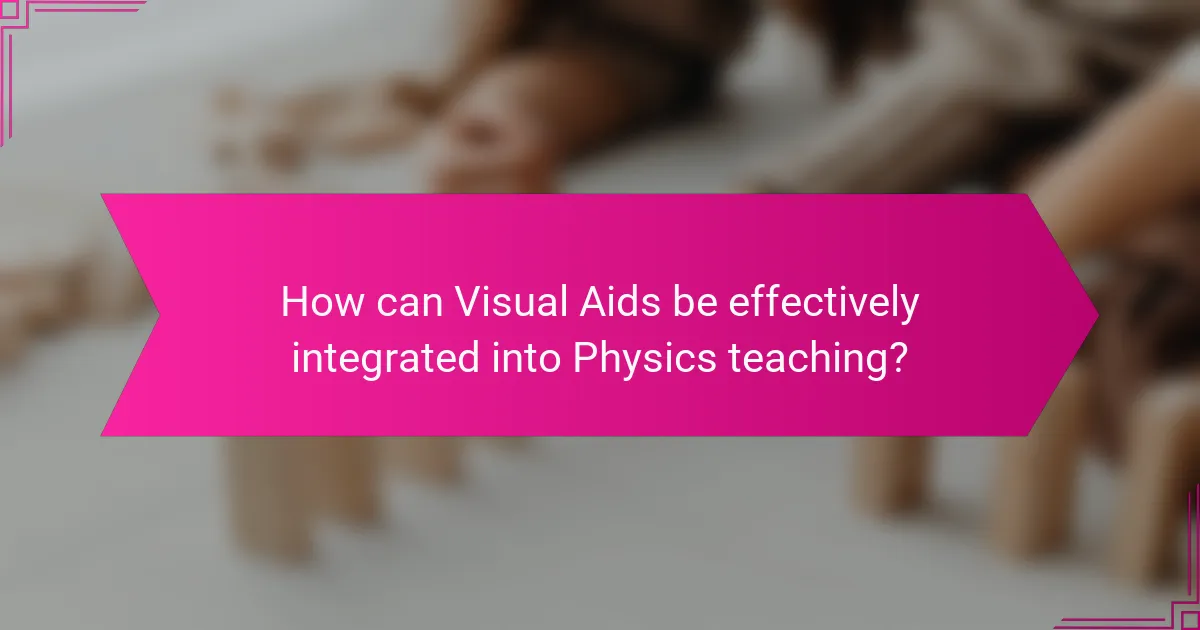
How can Visual Aids be effectively integrated into Physics teaching?
Visual aids can be effectively integrated into physics teaching by using diagrams, simulations, and models. Diagrams help illustrate complex concepts such as forces and motion. Simulations allow students to visualize experiments and phenomena that are difficult to observe in real life. Models provide tangible representations of abstract ideas, making them easier to understand.
Incorporating these tools can enhance student engagement and comprehension. Studies show that students who use visual aids perform better in assessments. For example, a study published in the Journal of Educational Psychology found that visual learning techniques improved students’ retention of physics concepts by 30%.
Thus, integrating visual aids into physics teaching supports learning and improves academic outcomes.
What strategies can teachers use to incorporate Visual Aids in their lessons?
Teachers can incorporate visual aids in their lessons through various strategies. One effective strategy is using diagrams to illustrate complex concepts. For example, physics teachers can use free-body diagrams to explain forces acting on an object. Another strategy is integrating videos that demonstrate experiments or real-world applications of physics principles. Research shows that multimedia presentations enhance student engagement and retention. Additionally, using models or simulations can help students visualize abstract concepts, such as atomic structure or wave behavior. Collaborative group activities that involve creating visual aids can also deepen understanding. According to studies, students who create their own visuals often achieve better learning outcomes. Lastly, incorporating infographics can summarize key information effectively, making it easier for students to grasp essential ideas.
How can Visual Aids be used to foster student engagement during lessons?
Visual aids can enhance student engagement during lessons by making complex concepts more accessible. They provide visual representations that simplify information. For example, diagrams can illustrate physics principles like force and motion. Charts can summarize data, making it easier to understand trends. Interactive visual aids, such as simulations, allow students to experiment in a controlled environment. Studies show that students retain information better when visual aids are used. Research indicates that visual learning can increase retention rates by up to 65%. This approach caters to diverse learning styles, ensuring that more students are engaged and involved in the learning process.
What are some common pitfalls to avoid when using Visual Aids?
Common pitfalls to avoid when using visual aids include overcrowding slides with information. This can overwhelm the audience and dilute key messages. Another pitfall is using low-quality images or graphics. Poor visuals can distract and confuse viewers. Additionally, failing to align visuals with spoken content can lead to misunderstandings. It’s also important to avoid excessive text on slides. Research shows that slides should support, not replace, verbal communication. Lastly, neglecting to practice with the visual aids can result in awkward transitions and technical difficulties during presentations.
What are best practices for utilizing Visual Aids in Physics learning?
Utilizing visual aids in physics learning enhances comprehension and retention. Best practices include aligning visuals with learning objectives. Use diagrams to illustrate complex concepts, such as forces and motion. Incorporate animations to demonstrate dynamic processes, like wave behavior. Employ simulations to allow interactive exploration of physical phenomena. Ensure visuals are clear and uncluttered to avoid confusion. Provide context by linking visuals to real-world applications. Encourage student engagement through discussions about the visuals. Regularly assess understanding to adjust visual aids accordingly. These practices have been shown to improve learning outcomes in physics education.
How can feedback improve the use of Visual Aids in the classroom?
Feedback can enhance the effectiveness of visual aids in the classroom by providing insights into student comprehension. It allows educators to identify which visual aids resonate with students. Additionally, feedback can highlight areas where visual aids may confuse learners. This process encourages teachers to adjust their materials based on student responses. Research indicates that tailored visual aids improve engagement and understanding. For example, a study by Hattie and Timperley (2007) emphasizes the importance of feedback in learning environments. Their findings suggest that effective feedback can lead to significant improvements in student performance. Thus, utilizing feedback can optimize the use of visual aids in physics education.
What tips can enhance the effectiveness of Visual Aids in lessons?
Use clear and relevant visuals to enhance understanding. Visual aids should directly relate to the lesson content. Incorporate diagrams, charts, and images that illustrate key concepts. Ensure visuals are high-quality and easy to read. Limit text on visuals to essential information only. Use color and contrast effectively to highlight important elements. Engage students by asking questions related to the visual aids. Encourage discussions that connect visuals to real-world applications. Research shows that effective visual aids can improve retention by up to 65%.
The main entity of this article is visual aids in physics learning. The article explores the types of visual aids, including diagrams, charts, models, and simulations, and their significant impact on comprehension and retention in physics education. It highlights the benefits of using visual aids, such as catering to diverse learning styles and enhancing student engagement. Key strategies for effectively integrating visual aids into teaching practices are also discussed, along with best practices and common pitfalls to avoid. Overall, the article emphasizes the importance of visual aids as essential tools for improving physics learning outcomes.
